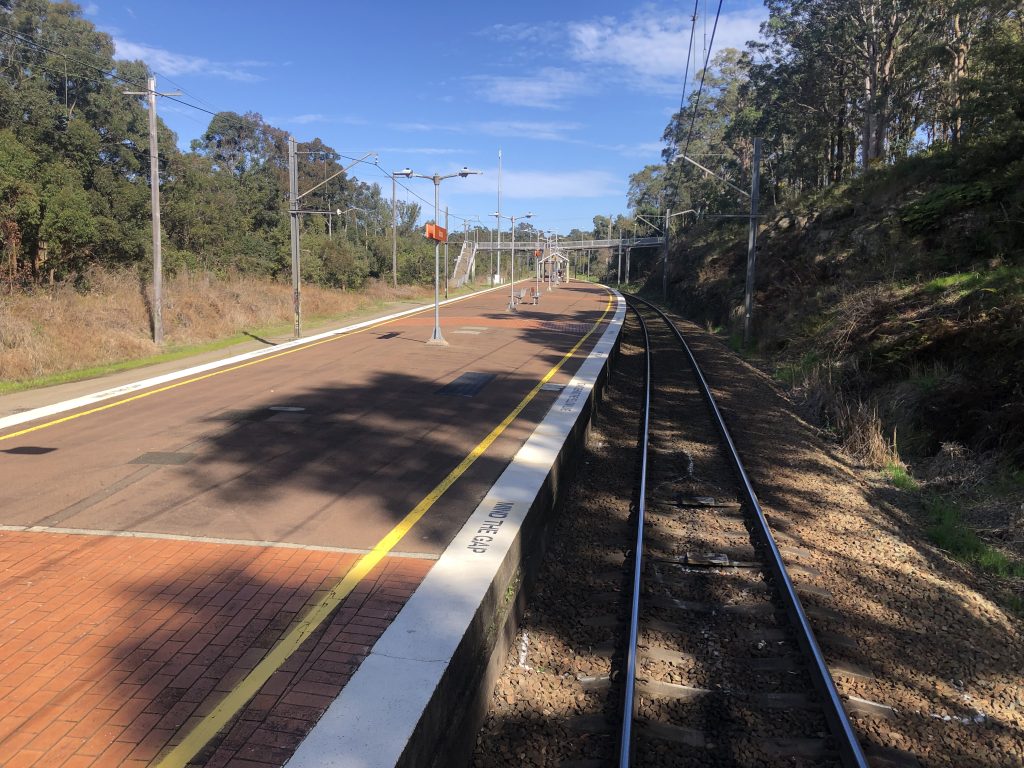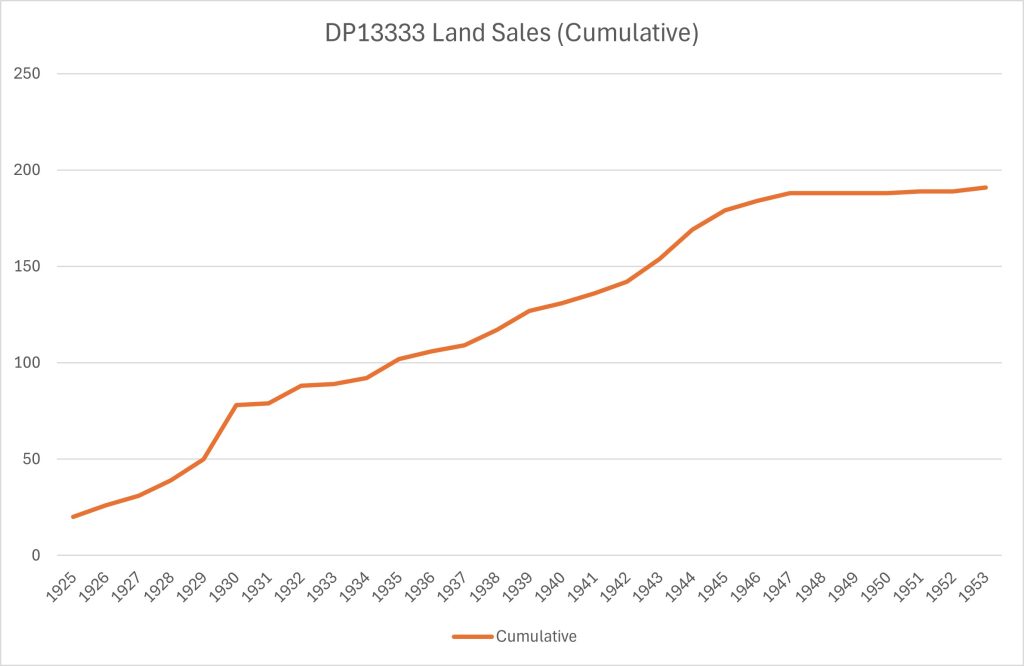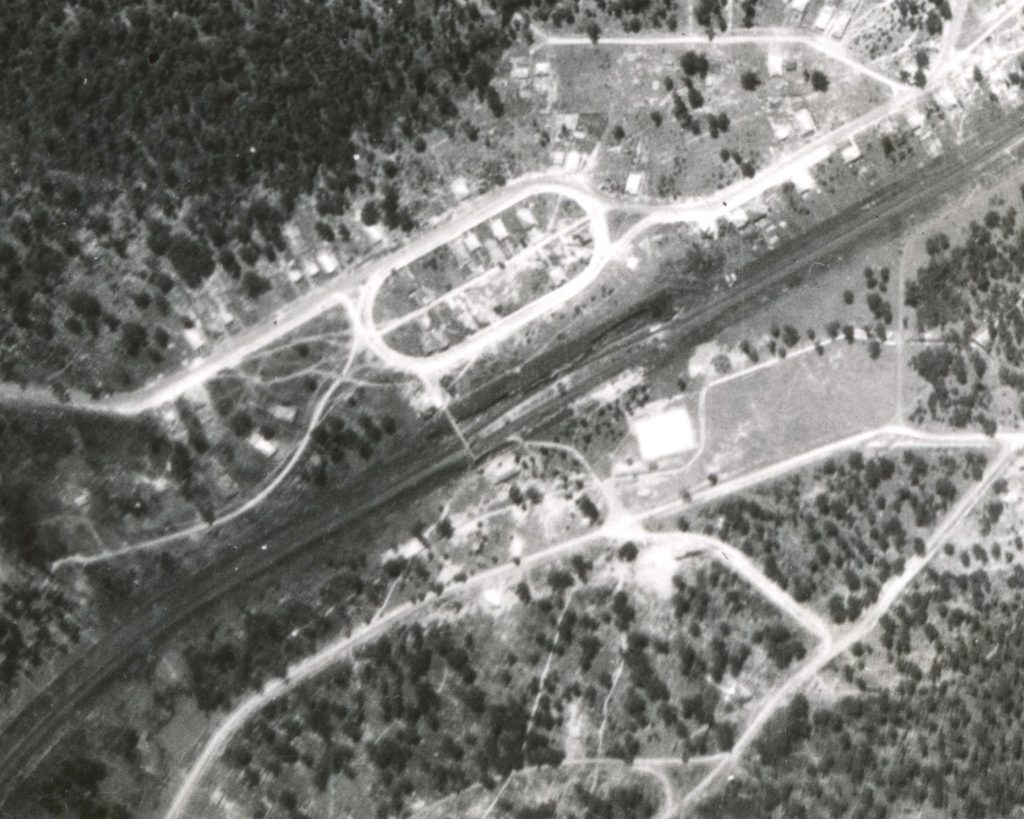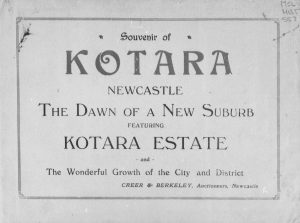In 1924 the Scottish Australian Mining Company, owners of the Lambton colliery, made plans to subdivide several hundred acres of their land to form a new suburb. To make the estate appealing to potential purchasers, the company constructed a new station on the Great Northern Railway that ran through the middle of their development.
Both the suburb and the station were originally intended to be named “Exton”. However, the Railway Commissioners, concerned that the name was too similar to other existing stations, chose instead the name “Kotara”, the Awabakal word for a hunting club. To avoid confusion, the developers then agreed to rename their subdivision to match the station.
For the first sale of land, held on site on Saturday 17 January 1925, the agents Creer and Berkeley produced a 40-page booklet with panoramic photos, glowing prose for the suburb, and praise for the new station.
“In order that every facility might be afforded to the residents of Kotara, a modern Railway Island Platform, 520ft in length, has been constructed in the Heart of the Suburb, and a regular service is maintained between Newcastle, the other Suburbs, and the Lake.”
In 1925 there were twelve train services each day, but as the platform was unstaffed, travellers faced the inconvenience of having to alight at the next station on the line to purchase tickets.
A century later, Kotara station is largely unchanged. There are now 25 train services each weekday, but a very low patronage of 90 passengers a day. This may change if the state government delivers on their recently announced “Transported Oriented Development Program”, which aims to streamline the development of mid-rise housing (up to 6 storeys) within 400 metres of selected railway stations, including Kotara.
In examining the birth of Kotara 100 years ago, it is interesting to note how the development of housing and the provision of public transport occurred together. Now that’s a practice from the past I’d love to see followed in the future.


The article above was first published in the October 2024 edition of The Local.
Additional Information
Kotara Railway Station
For the current day passenger numbers at Kotara Station, I used the Train and Metro Station Monthly Usage numbers from the NSW government Open Data website. This showed that entries and exits totalled 2747 for the month of July 2024. This equates to an average of 89 trips per day, to or from the station.

Kotara Estate
As early as July 1922 there were reports that the Scottish Australian Mining Company planned to subdivide their land adjoining the Tickhole Tunnel of the Great Northern Railway. By October 1923, plans had been drawn up for the subdivision. In 1924 the Kotara Railway Station was constructed, and the streets of the new subdivision prepared, in readiness for the initial big land sale to take place on Saturday 17 January 1925.

The plans have been prepared for the Scottish-Australian Mining Company of a subdivision of about 200 blocks of land contiguous to the railway line on both sides. For many years eyes have been cast on this area, which lies between the Adamstown railway station and the Tickhole tunnel, and is within easy distance of the city. The design of the big subdivision conforms with the new ideas planning for model suburbs, and provision has been made for park areas, children’s playgrounds, street gardens, plantations, and other recreative utilities. The company has entered into an agreement with the Railway Commissioners for the erection of a railway platform to serve the area.
Newcastle Morning Herald and Miners’ Advocate, 17 October 1923.

Although the initial reports of the auction on 17 January 1925 stated that “160 lots were disposed of in about two hours”, the land wasn’t formally sold at this time, it was just people signing up with intention to purchase. At that time New Lambton Council (the municipality in which the land was located) still hadn’t formally approved the subdivision, being in dispute with the developer about various matters including access to Charlestown Road, and the width of the main streets in the subdivision. After resolving matters, New Lambton council finally approved the subdivision in May 1925. The deposited plan DP13333 for the subdivision was lodged with the Department of Lands on 27 August 1925.

Transfers of title arising from land sales in the subdivision subsequently appear in Volume-Folios 905-119, 3878-122, 4350-65, and 5604-172. The first transfer recorded is for Lot 97 Sec A to Leslie Arthur Fitness on 15 September 1925, and the final transfer was for Lot 51 Section B to Thomas Egginton on 21 October 1953.
Despite the January 1925 article reporting that 160 lots had been sold, actual sales and transfers of title occurred over a very long period of time. Examination of the land title records shows that it took until 1944 before 160th lot sold. How much of this delay was due to slowness in purchasers finalising their transaction, and much due to purchases foregoing/forfeiting their lot due to economic pressures is uncertain.



Newspaper articles
| Article Date Event Date | Notes |
|---|---|
| 26 Jul 1922 | "At the present time the Scottish-Australian Company and the Kinnaird Land Syndicate are about to subdivide their estates adjoining the Tickhole Tunnel, and property running between New Lambton and Tickhole Tunnel and Charlestown. This property is most ideal for suburban residences, being four miles from the Broadmendow station, and served by two railways, the Sydney line and the Waratah coal line. At the present time it is anticipated that the Scottish-Australian Company will build a railway station on their land between Adamstown and the Charlestown Tunnel and then subdivide." |
| 17 Oct 1923 | "The plans have been prepared for the Scottish-Australian Mining Company of a subdivision of about 200 blocks of land contiguous to the railway line on both sides … The company has entered into an agreement with the Railway Commissioners for the erection of a railway platform." |
| 3 Oct 1924 | "It is authoritatively stated that the name of the station in connection with the new subdivision at present known as Exton has been altered to Kotara. This has been brought about by the suggestion of the Lands Department and the Railway Commissioners. The vendors of the estate, the Scottish-Australian Mining Company, Limited, having undertaken the cost of the construction of a new station, desired to have it named Exton in keeping with the township, but the departments pointed out the similarity to the name of other stations and the possibility of confusion arising. They suggested a native name, and with a view of obtaining something appropriate the agents. Messrs. Creer and Berkeley, enlisted the services of Mr. J. J. Moloney, who submitted a long list of local aboriginal names, from which Kotara was finally chosen. The construction work of the railway platform will be finished in a few weeks, and its train service will be of considerable advantage to all those people living on the northern side of Cardiff, at Charlestown, and the south-western side of New Lambton or Orchardtown, as it is more familiarly known." |
| 9 Oct 1924 8 Oct 1924 | New Lambton Council meeeting … "Correspondence was received from S.A.M. Company, stating that as the Railway Commissioners had decided to call the railway station situated near Cardiff tunnel, in their subdivision, Katara (sic), they had renamed the subdivision Katara in lieu of Exton. The Mayor said that the Railway Commissioners had acted discourteously in not conferring with the council re the naming of the station." |
| 10 Nov 1924 | "The new railway station at Kotara, on the Newcastle to Sydney line, has been completed by a Scottish-Australian mining company. The cost was borne solely by the company which, however, may be compensated after three years by the Commissioners if traffic justifies it. The new station is situated between Adamstown and the Cardiff tunnel, and will serve a fairly large population. The necessary overhead bridges have been erected, and the platform is of island design." |
| 19 Nov 1924 | "The new railway station at Kotara is already being availed of, as certain trains from Toronto are stopping there." |
| 16 Jan 1925 17 Jan 1925 | "Kotara, the newly subdivided suburb of Newcastle, has been the object of considerable interest for some time past amongst land speculators and investors generally. The sale of the land will be conducted to-morrow (Saturday), by Messrs. Creer and Berkeley. Easy terms of payment have been arranged, and the sale should be a big success." |
| 20 Jan 1925 17 Jan 1925 | "One of the most successful land subdivision sales held in this district was that of Kotara, conducted by Messrs. Creer and Berkeley, on Saturday afternoon last. The result evidences the importance of transit. The vendors, the Scottish-Australian Mining Company, Limited, realising this, undertook the responsibility of having a railway station erected in the centre of the estate. This convenience, a run of only 19 minutes from the central station, Newcastle, with a service of some 12 trains a day, each way, was no doubt a great factor in attracting upwards of 600 people to the sale, when 160 lots were disposed of in about two hours." |
| 30 Jan 1925 29 Jan 1925 | "A well-attended meeting of purchasers of land at Kotara was held last night at the rooms of Messrs. Creer and Berkeley, when a progress committee was formed. The meeting prepared a lengthy agenda of work and improvements to be effected, and the association will particularly watch the parks, railway facilities, supply of water, gas and electric light, and generally assist home builders to embrace modern ideas in keeping with a district so full of residential possibilities." |
| 10 Feb 1925 | "New Lambton Council is not satisfied with the plans for the subdivision of portion of the Scottish-Australian Mining Company's Estate at Kotara … The plans did not provide for any outlet to Charlestown-road … the council would insist on the main road being 22 feet wide, instead of 16 feet." |
| 8 May 1925 | "The Kotara Estate subdivision has at last received the legal approval of New Lambton Council. For a considerable time the finalising has been held up, although the greater part of the subdivision has been sold." |
| 22 May 1925 | "As [Kotara] is gradually growing in importance, and trains are being stopped to pick up and set down passengers, the regulations that tickets must be got at Adamstown is becoming more and more irksome. The other morning half a dozen persons, who got into the train at Kotara, had to alight at Adamstown to get their tickets en route to Newcastle. The train, in consequence, was delayed for about two minutes." |
| 29 May 1925 | "The monthly meeting of the Kotara Progress Association was held last night … the vendors of the estate, the Scottish-Australian Mining Company, Limited, set aside large areas for park and recreation purposes, and it is the planting and improvement of these reserves that is engaging attention." |
| 30 Sep 1925 | "One of the biggest residential estate developments in the Newcastle district was inaugurated at the beginning of this year, when the Kotara subdivision was made available. It comprises several hundred acres, lying between Adamstown railway station and Tickhole tunnel, five miles from Newcastle. The first sale in the estate was conducted on January 17 by Messrs. Creer and Berkeley acting for the Scottish-Australian Mining Company. There were 191 allotments offered and over 160 were sold on the day. The success of the sale was largely due to the enterprise of the vendors. About three miles of streets had been made, and a railway island platform 520 feet in length constructed in the centre of the new suburb. With the object of assisting in the development of the suburb, purchasers of blocks formed a progress association, which now has a membership of between 70 and 80." |

